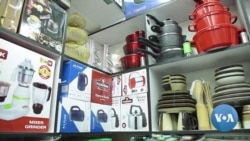ຈີນຍັງຄົງເປັນແຫຼ່ງຂອງການນຳເຂົ້າອັນດັບໜຶ່ງຕໍ່ເຄັນຢາ, ເຊິ່ງກວມເອົາຫຼາຍກວ່າ 20 ເປີເຊັນຂອງການນຳເຂົ້າທັງໝົດ, ອີງຕາມສຳນັກງານສະຖິຕິຂອງປະເທດ. ບັນດາຜູ້ຜະລິດຢູ່ໃນທ້ອງຖິ່ນຈໍານວນຫຼາຍກ່າວວ່າ ການນໍາເຂົ້າ ຂອງຈີນ ກໍາລັງສົ່ງຜົນກະທົບຕໍ່ລາຍໄດ້ທັງໝົດຂອງພວກເຂົາເຈົ້າ. ຈູມາ ມາຈັງກາ (Juma Majanga) ລາຍງານຈາກນະຄອນຫຼວງໄນໂຣບີ, ປະເທດເຄັນຢາ. ທິບສຸດາ ມີລາຍລະອຽດ.
ຕະຫຼາດຄາມູຄຸນຈີ (Kamukunji) ໃນນະຄອນຫຼວງໄນໂຣບີ ແມ່ນເຕັມໄປດ້ວຍ ສິນຄ້າທີ່ນໍາເຂົ້າຈາກ ຈີນ. ທ່ານນາງຄຣິສຕີນ ເອັນເຈີຣີ (Christine Njeri) ເຊິ່ງເປັນແມ່ຄ້າຢູ່ທີ່ນີ້ ແລະເປັນເຈົ້າຫນ້າທີ່ຂອງສະຫະພັນ ຜູ້ຄ້ານໍາເຂົ້າໃນນະ ຄອນຫຼວງໄນໂຣບີ. ທ່ານນາງກ່າວວ່າ ໂຕຂັບເຄື່ອນສໍາຄັນ ຂອງຜະລິດຕະພັນ ຈີນແມ່ນລາຄາທີ່ຕໍ່າຂອງພວກເຂົາ.
ທ່ານນາງຄຣິສຕີນ ເອັນເຈີຮີ ກ່າວເປັນພາສາສະວາຮີລີວ່າ:
“ເມື່ອພວກເຈົ້າສົມທຽບລາຄາສິນຄ້ານຳເຂົ້າຂອງສິນຄ້າຈີນ ກັບສິນຄ້າທີ່ຜະລິດຢູ່ທ້ອງຖິ່ນ, ເຄື່ອງນຳເຂົ້າຂອງຈີນແມ່ນຖືກກວ່າ. ສະນັ້ນ, ໃນຖານະທີ່ເປັນຜູ້ ຄ້າ, ຂ້ອຈະຕ້ອງຍຊອກຫາສິນຄ້າທີ່ມີລາຄາຖືກກວ່າ ເຊິ່ງວ່າຂ້ອຍສາມາດຂາຍ ແລະສ້າງກໍາໄລໄດ້."
ທ້າວໂມສຊີສ ວາຊີຣາ (Moses Wachira) ລູກຄ້າຂອງ ນາງເອັນເຈີຣີ, ລາວສະທ້ອນໃຫ້ເຫັນເຖິງຄວາມຮູ້ສຶກຂອງ ນາງເອັນເຈີຣີ.
ລາວກ່າວເປັນພາສາສະວາຮິລີວ່າ:
"ຜະລິດຕະພັນຂອງ ເຄັນຢາ ເປັນສິ່ງຂັດຂວາງໃນການໃຊ້ຈ່າຍສໍາລັບພວກ ເຮົາ. ບາງຄັ້ງ ພວກເຮົາຊື້ມັນເມື່ອພວກເຮົາບໍ່ມີທາງເລືອກອື່ນ, ແຕ່ມັນມີລາຄາ ສູງເກີນໄປ. ພວກເຮົາເລືອກຜະລິດຕະພັນຂອງຈີນ."
ໃນຕົ້ນປີນີ້, ບັນດາຜູ້ຄ້າຂາຍຂະໜາດນ້ອຍໃນນະຄອນຫຼວງໄນໂຣບີ ໄດ້ຈັດ ການປະທ້ວງຢູ່ໃນເມືອງຂຶ້ນ ເພື່ອຮ້ອງທຸກກ່ຽວກັບສິ່ງທີ່ເຂົາເຈົ້າກ່າວວ່າ ເປັນການແຂ່ງຂັນທີ່ບໍ່ຍຸດຕິທຳຈາກຄູ່ຄ້າຈີນຂອງພວກເຂົາ.
ນາງເອັນເຈີຣີ ກ່າວວ່າ ພວກພໍ່ຄ້າຈີນໄດ້ຂ້າມເຂົ້າໄປໃນຊ່ອງຫວ່າງຂອງພວກເຂົາເຈົ້າແລ້ວ.
ນາງເອັນເຈີຣີ ກ່າວວ່າ:
"... ຖ້າຜູ້ຜະລິດມາຈາກປະເທດຈີນ ແລະເລີ່ມຂາຍຜະລິດຕະພັນໃນປະເທດ ເຄນຢານີ້, ນັ້ນຫມາຍຄວາມວ່າ ພວກເຮົາຜູ້ຄ້າຂາຍຊາວເຄນຢາ ຈະຕ້ອງຖືກ ຜັກດັນອອກຈາກການເຮັດທຸລະກິດ."
ຈີນ ຍັງຄົງເປັນແຫຼ່ງນຳເຂົ້າຜູ້ດຽວຂອງສິນຄ້ານຳເຂົ້າໃນເຄັນຢາ, ເຊິ່ງກວມເອົາ 20.5 ເປີເຊັນຂອງການນຳເຂົ້າທັງໝົດ, ອີງຕາມສຳນັກງານສະຖິຕິຂອງປະເທດ. ບັນດາຜູ້ຜະລິດຊາວເຄັນຢາກ່າວວ່າ ປະລິມານການນໍາເຂົ້າທີ່ສູງ ເຮັດໃຫ້ ອຸດສາຫະກໍາທ້ອງຖິ່ນພົບຄວາມຫຍຸ້ງຍາກ. ພວກເຂົາເຈົ້າຢາກໃຫ້ລັດຖະບານ ວາງມາດຕະການ ເພື່ອຄຸ້ມຄອງທຸລະກິດຂອງພວກເຂົາເຈົ້າ, ລວມທັງຫຼຸດຜ່ອນ ພາສີ ເພື່ອຫຼຸດຕົ້ນທຶນໃນການຜະລິດ.
ທ່ານ ແອນໂທນີ ມະວາງກີ (Anthony Mwang), ຜູ້ບໍລິຫານໃຫຍ່ຂອງສະ ມາຄົມຜູ້ຜະລິດ ເຄັນຢາ ກ່າວວ່າ:
“ພວກເຮົາມີຫຼາຍອົງການ…ອົງການລະບຽບການແລະອົງການລັດຖະບານ ທີ່ມີສ່ວນຮ່ວມໃນສິ່ງທີ່ພວກເຮົາດໍາເນີນງານ. ພວກເຮົາຊິເຮັດແນວໃດເພື່ອໃຫ້ໝັ້ນ ໃຈວ່າ ມີການປະສານງານຂອງພວກເຂົາເຈົ້າ? ພວກເຮົາຊິເຮັດແນວໃດເພື່ອໃຫ້ ໝັ້ນໃຈວ່າມັນຈະບໍ່ມີການທັບຊ້ອນກັນ? ເຮັດແນວໃດພວກເຮົາຊິໝັ້ນໃຈໄດ້ວ່າ ສະພາແຫ່ງຊາດແລະກົດຫມາຍທັງຫມົດທີ່ກໍາລັງຈະເກີດຂຶ້ນ, ພ້ອມດ້ວຍນະໂຍ ບາຍໃນອະນາຄົດ, ແມ່ນແທ້ຈິງແລ້ວຈະພັດທະນາການຜະລິດ, ບໍ່ແມ່ນການຊຸກ ຍູ້ການນໍາເຂົ້າ ແລະການບໍລິໂພກ."
ມັນໄດ້ມີການໂຕ້ຖຽງກັນມາດົນນານກ່ຽວກັບຄຸນນະພາບຂອງຜະລິດຕະພັນຈາກຈີນທີ່ມີລາຄາຖືກໃນຕະຫຼາດເຄັນຢາ ພ້ອມດ້ວຍຫຼາຍໆຄໍາຖາມກ່ຽວກັບຄຸນນະພາບໃນຜະລິດຕະພັນຂອງພວກເຂົາ.
ແລະເຖິງວ່າຈະມີສິນຄ້າຂອງຈີນທີ່ມີລາຄາຖືກຢ່າງຫຼວງຫຼາຍຢູ່ໃນປັດຈຸບັນ, ທ່ານມະວາງກີ ກ່າວວ່າ ໃນໄລຍະ 25 ປີຕໍ່ໜ້າ, ອາຟຣິກາຈະເປັນແນວໜ້າຂອງການຜະລິດທຸກປະເພດ.
ທ່ານແອນໂທນີ ມະວາງກີ ກ່າວວ່າ:
“ອາຟຣິກາຈະມີກໍາລັງແຮງງານທີ່ໃຫຍ່ທີ່ສຸດ, ອາຟຣິກາແມ່ນຕັ້ງຢູ່ໃນເຂດຮ້ອນ ດັ່ງນັ້ນ ພວກເຮົາຈຶ່ງເຂົ້າເຖິງພະລັງງານແສງຕາເວັນໄດ້. ອາຟຣິກາມີການເຂົ້າເຖິງຊັບພະຍາກອນທົດແທນເຊັ່ນແມ່ນໍ້າ ຖ້າເຈົ້າໄປແມ່ນໍ້າຄົງໂກ ແລະອື່ນໆຢູ່ທີ່ ນັ້ນ. ອາຟຣິກາ ຈະມີເນື້ອທີ່ດິນປູກຝັງ 50 ເປີເຊັນ, ອະນາຄົດແມ່ນຢູ່ໃນອາຟຣິກາ.”
ແຕ່ທ່ານ ມະວາງກີ ຍັງກ່າວອີກວ່າ ບັນດາປະເທດໃນອາຟຣິກາຕ້ອງປັບປຸງ ແລະ ຍົກລະດັບພື້ນຖານການຜະລິດຂອງຕົນ ເພື່ອແຂ່ງຂັນກັບບັນດາບໍລິສັດຍັກໃຫຍ່ຢູ່ໃນໂລກເຊັ່ນ ຈີນ ແລະຮັບຮູ້ຄວາມສາມາດຂອງຕົນໃນຖານະເປັນສູນກາງການຜະລິດຂອງໂລກ.
China remains the single leading source of imports to Kenya, accounting for over 20 percent of total imports, according to the country’s bureau of statistics. Many local manufacturers say the Chinese imports are hurting their bottom line. Juma Majanga reports from Nairobi, Kenya.
The Kamukunji market in Nairobi is full of Chinese imported goods. Christine Njeri is a trader here and an official of the import traders’ union in Nairobi. She says the main driver of Chinese products is their low prices.
Christine Njeri, Trader, Female, in Swahili
“When you compare the price of Chinese imports and locally manufactured goods, the Chinese imports are cheaper. So, as a trader, I look for where price is cheaper so that so that I can sell and make some profit.”
Moses Wachira is Njeri’s customer. He echos Njeri’s sentiments.
Moses Wachira, Buyer, Male, in Swahili
“Kenyans products are cost-barring for us. Sometimes we buy them when we have no alternative, but it is too costly. We prefer Chinese products.”
Earlier this year, small scale traders in Nairobi held demonstrations in the city to complain about what they say is unfair competition from their counterparts from China.
Njeri says Chinese traders had crossed into their space.
Christine Njeri, Trader, Female, in Swahili
“... if the producer comes from China and starts selling the products here in Kenya, that means that we Kenyan traders would be pushed out of business.”
China remains the single leading source of Kenya’s imports, accounting for 20.5% of total imports, according to the country’s bureau of statistics. Kenyan manufacturers say that high volume of imports is suffocating local industry. They want the government to put measures in place to protect their businesses, including a reduction in taxes to lower the cost of manufacturing.
Anthony Mwangi is the chief executive officer of the Kenya Association of Manufacturers.
Anthony Mwangi, Kenya Association of Manufacturers CEO, Male, in English
“We have so many agencies…regulatory agencies and government agencies that are involved in what we do. How do we make sure that there is coordination of them? How do we make sure that there is no overlap? How do we make sure that parliament and all the laws that are coming up, and policy coming up, are actually to progress production, not to encourage importation and consumption.”
There has long been debate over the quality of cheap Chinese products in the Kenyan market with many questioning their quality.
And despite the current glut of cheap Chinese goods, Mwangi says over the next 25 year, Africa will be at the forefront of all kinds of manufacturing.
Anthony Mwangi, Kenya Association of Manufacturers CEO, Male, in English
“Africa will have the largest workforce; Africa is in the tropics; so that we have access to solar energy. Africa has access to renewable resources like rivers; if you go to River Congo and others that are there. Africa will have 50% of the arable land…the future is in Africa.”
But Mwangi also says African countries have to modernize and update their manufacturing base to compete with global giants like China and realize their potential as a world manufacturing hub.





